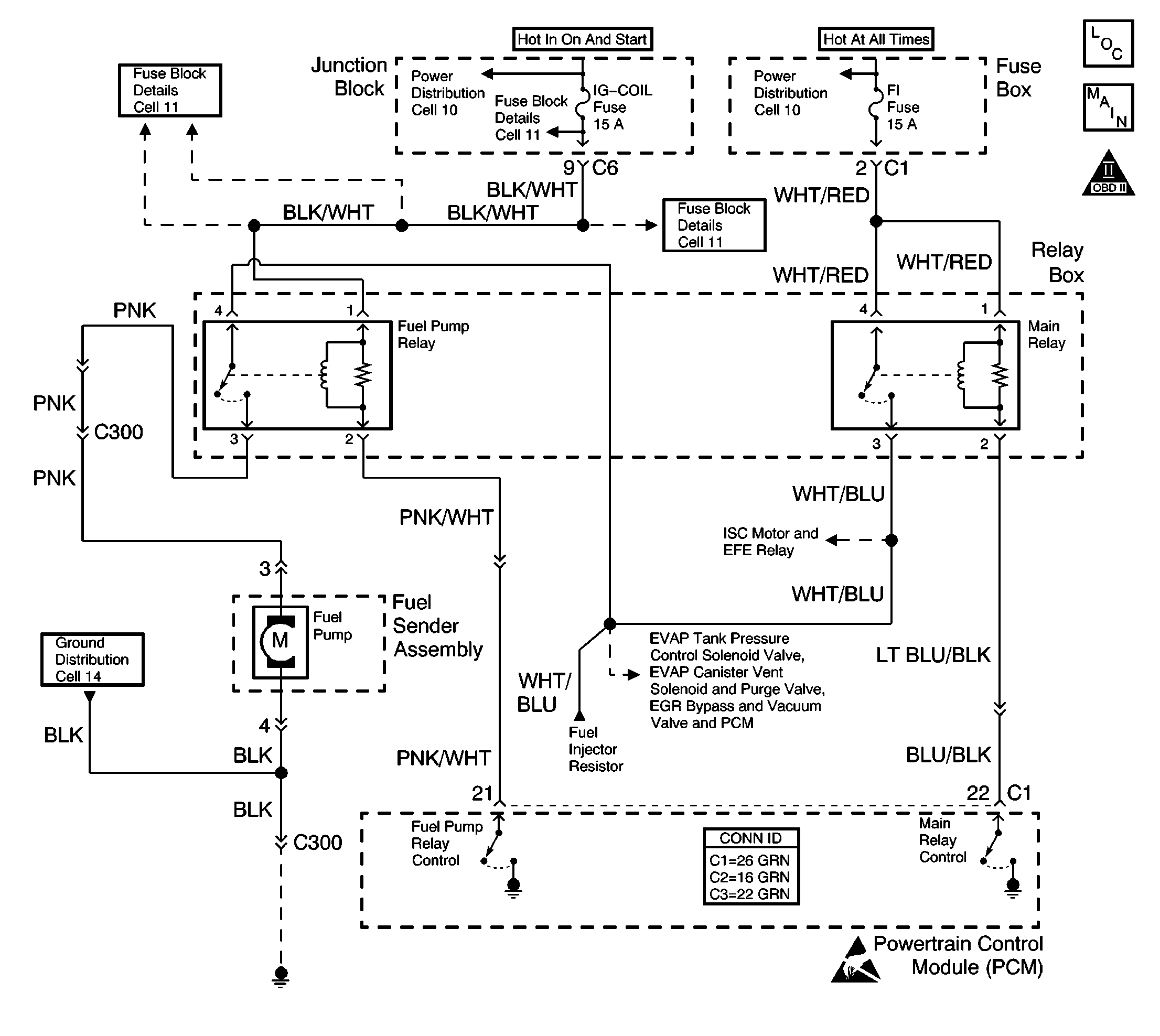
Circuit Description
The Powertrain Control Module (PCM) will energize the fuel pump relay for 2 seconds when the ignition switch is turned to the ON position. When the fuel pump relay is energized the fuel pump will operate and pressurize the fuel system. The fuel pump will continue to operate as long as the PCM is receiving ignition system reference pulses. The fuel pump will stop after 2 seconds if ignition system reference pulses are not detected.
Diagnostic Aids
Check for any of the following conditions:
| • | Check the resistance of the fuel pump relay. The resistance across terminal 1 and terminal 2 is 79-95 ohms at 20°C (68°F). The resistance across terminal 3 and terminal 4 is infinite. |
| • | The fuel pump relay's electrical contacts may be pitted or sticking. Replace the fuel pump relay if tapping gently on the relay or wiggling the relay causes a change in the relay's operation. |
| • | The performance of the fuel pump relay may be affected by temperature. Check the fuel pump relay after sitting outside overnight and after running the engine 30 minutes. |
Normal fuel pump electrical resistance is 0.8-1.5 ohms at 20°C (68°F).
An intermittent malfunction may be caused by a problem in the fuel pump electrical circuit. Inspect the wiring harness and components for any of the following conditions:
| • | Backed out terminals. |
| • | Improper mating of terminals. |
| • | Broken electrical connector locks. |
| • | Improperly formed or damaged terminals. |
| • | Faulty terminal to wiring connections. |
| • | Physical damage to the wiring harness. |
| • | Broken conductor inside the wire insulation. |
| • | Corrosion of electrical connections, splices, or terminals. |
Use the following relay cavity table in order to locate the correct cavities to probe during diagnosis. The table layout corresponds to the cavity layout of the relay block.
Relay Cavity Identification | |
|---|---|
Switch Power | |
Switch Load | |
Coil Power | Coil Ground |
Test Description
The numbers below refer to the step numbers in the Diagnostic Table.
-
The Powertrain OBD System Check prompts the technician to complete some basic checks and store the freeze frame data on the scan tool if applicable. This creates an electronic copy of the data taken when the fault occurred. The information is then stored in the scan tool for later reference.
-
This step checks the fuel pump operation with the ignition switch in the ON position.
-
This step checks the fuel pump relay control circuit.
Step | Action | Value(s) | Yes | No |
|---|---|---|---|---|
Did you perform the Powertrain On-Board Diagnostic System Check? | -- | |||
Does the fuel pump operate for approximately 2 seconds? | -- | |||
Is the test lamp ON while cranking the engine? | -- | Go to Fuel System Diagnosis | ||
4 |
Is the test lamp ON? | -- | ||
5 |
Is the fuel pump ON? | -- | ||
6 |
Is the test lamp ON? | -- | ||
7 |
Is the test lamp ON? | -- | ||
8 | Replace the fuel pump. Refer to Fuel Pump Replacement . Is the action complete? | -- | -- | |
9 | Repair the open or the short in the WHT/BLU wire between the main relay and the fuel pump relay. Is the action complete? | -- | -- | |
10 | Repair the open or the short in the PNK wire between the fuel pump and the fuel pump relay. Is the action complete? | -- | -- | |
11 | Repair the ground connection or the open in the fuel pump ground circuit. Is the action complete? | -- | -- | |
12 |
Is the test lamp ON? | -- | ||
13 | Probe the fuel pump relay connector cavity 2 with a test lamp connected to B+. Is the test lamp ON while cranking the engine? | -- | ||
14 | Backprobe the fuel pump relay control circuit at the PCM with a test lamp connected to B+. Is test lamp ON while cranking the engine? | -- | ||
15 | Repair the open or the short in the IG-COIL fuse circuit (BLK/WHT wire). Is the action complete? | -- | -- | |
16 | Replace the fuel pump relay. Refer to Fuel Pump Relay Replacement . Is the action complete? | -- | -- | |
17 | Repair the open in the fuel pump relay control circuit between the fuel pump relay and the PCM. Is the action complete? | -- | -- | |
18 | Replace the PCM. Refer to Powertrain Control Module Replacement . Is the action complete? | -- | -- | |
19 | Operate the vehicle within the conditions under which the original symptom was noted. Does the system now operate properly? | -- | System OK | Go to Diagnostic Aids |
